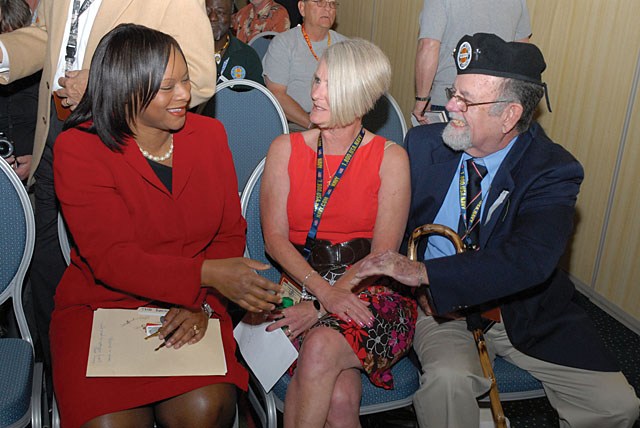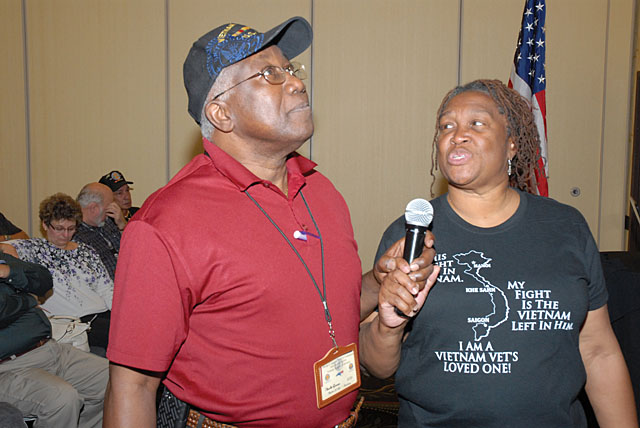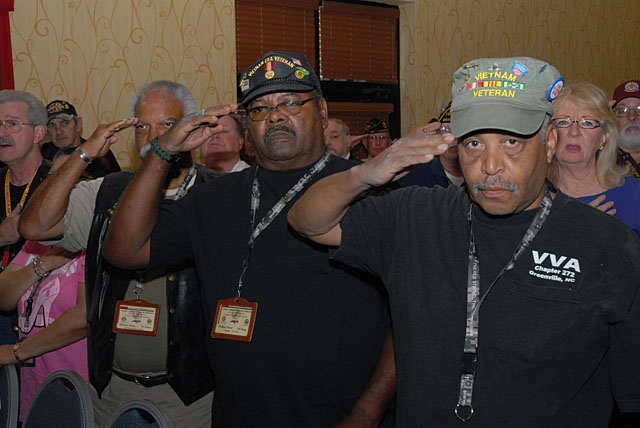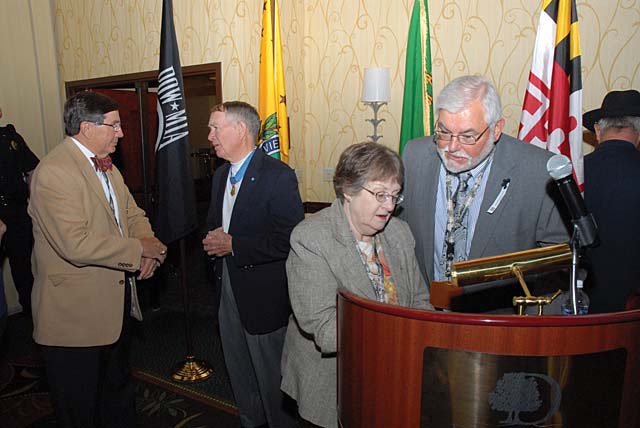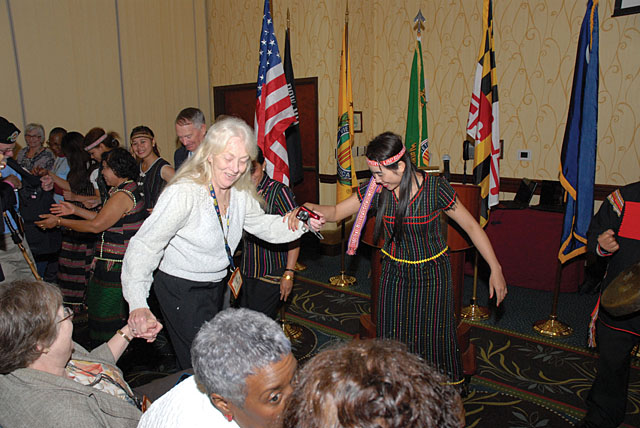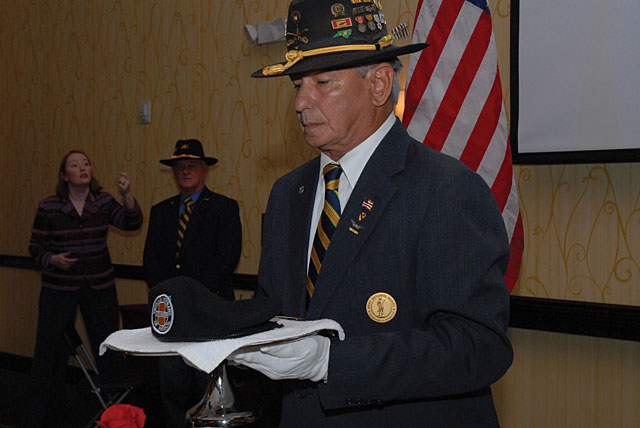 |
||||||||||||
|
May/June 2012
Veterans Helping Veterans: PHOTOS & STORY BY MICHAEL KEATING “We wanted it to be based on a theme,” North Carolina State Council President Joe Kristek said of the 23rd George C. Duggins Region 3 Conference held in Asheville March 28-31. In concert with a twelve-man planning committee, “we looked at the place in our lives. The important issues seemed to revolve around health care.” Finally, a unifying theme was decided upon: “Veterans helping veterans.” They took a lean and trim approach to the seminars. “We only had seven,” North Carolina Vice President Rossi Nance said. They decided against concurrent seminars, which often require attendees to run from the first part of one to the last part of another. “We let each one stand on its own merits,” he added. Discussion, then, both during the seminars and directly afterward, remained focused. The speakers were experts in their fields; they all lived and worked in Region 3; and they all had volunteered their time. Region 3—made up of North Carolina, South Carolina, Kentucky, Tennessee, Virginia, West Virginia, Maryland, and the District of Columbia—is the only VVA region that consistently produces conferences for members. The combined Region 8 and 9 conferences are the other exception. The conference dates were suggested by the host hotel, The DoubleTree Biltmore, whose staff couldn’t have been more gracious or helpful. “They said they could provide us the best rates on that week, so we took them,” Nance said. Unfortunately, those dates coincided with Vietnam Veterans Recognition Day, so there was competition from a NASCAR event in nearby Charlotte that anticipated 70,000 veterans, and the West Virginia State Council’s recognition event in Charleston. Nonetheless, three national officers attended: President John Rowan, Vice President Fred Elliott, and Treasurer Wayne Reynolds. The keynote speaker at the Opening Ceremonies was the soft-spoken and self-effacing Walter J. Marm, who received the Medal of Honor for his actions at the Ia Drang. During “a slugfest [that lasted] for three days,” he took out three NVA near a machine-gun site. Later, he exposed himself to enemy fire to pinpoint its location, then charged the nest and threw in a grenade that killed several more enemy. With his M-16 he shot four more NVA until he took a bullet in the jaw. “I’m no braver than anyone else here,” he said. “I’m just the caretaker of this medal.” In fact, he said, “some say it’s harder to wear the medal than to earn it.” Marm is one of eighty-one living MOH recipients. The main mission of the Congressional Medal of Honor Society is to “work with the youth” to build character. It is also committed to such veterans’ issues as PTSD and Agent Orange. Marm was followed by George E. Clark, a former Special Forces soldier in Vietnam with a life-consuming mission: to help the Montagnards. But his mission is not the product of detached altruism. It’s public: “The Montagnards were the best and most unwavering ally the U.S. had,” Clark said. And it’s private: “When I was hit, they jumped on my body so I wouldn’t get hit again.” Most Montagnards in the United States—more than eight thousand—live in North Carolina. Clark’s organization, Save the Montagnard People, works to resettle them, preserve their culture, and help adapt them to the broader American culture. He estimates that eleven hundred Montagnard children have gone through college. Long persecuted by the Vietnamese, who are different ethnically and practice different religions, the Montagnards made perilous escapes from their homelands. With the help of STMP and other organizations, they made their way to the United States. In the best of all worlds, they would prefer to stay in their native home in the Central Highlands. “They don’t want to come here,” Clark said, “but they don’t want to be slaughtered.” Only a fraction of their wartime numbers remains in Vietnam. After Clark spoke, Montagnard men and woman played instruments and danced, ultimately drawing Marm, NCSC Chaplain Craig Register, AVVA Region 3 Director Donna Crowell, and others out to dance with them. Later, representatives of the Eastern Cherokee Nation (who were also veterans) were presented to the Conference and to the Montagnards. In a spare but moving ceremony, these two displaced indigenous peoples exchanged gifts. The seminars were spread over a three-day period. AVVA North Carolina State Rep Pam Scheffer discussed survivor assistance. Debra Volkmer, the VISN 6 caretaker support coordinator, made two presentations, one on accessing caregiver support from the VA (for details, see www.caregiver.va.gov or call 855-260-3274). The other seminar was on vicarious traumatization, otherwise known as secondary PTSD. She approached the subject from psychological, physical, and spiritual perspectives. Anthony Musolino’s presentation was entitled, “Who Will Cash Your Last Check?” Mary Foster talked about future home health care, and Darlene Laughter discussed volunteer opportunities with the VA. North Carolina Cemetery Program Director Eli Panee presented an overview on veterans cemeteries. Region 3 Director Sara McVicker tended to VVA business, presenting a seminar entitled “Reporting,” in which she described the paperwork that chapters and state councils must file with the state, the federal government, and VVA national. Because filing requirements vary from state to state, McVicker provided a breakout of agencies and their email and street addresses for each of the Region 3 states. She stressed that all chapter officers and board members must know the filing requirements: It is foolish and dangerous to leave that responsibility with one person, she said. Later in the day McVicker held a Region 3 Director’s Meeting, in which she discussed the current business of the National Board of Directors and progress in resolving software problems. Saturday morning Ellie Covan made an often-emotional presentation based on her research at the University of North Carolina on the long road home for Vietnam veterans and the spouses who have attached their lives to them. Her investigations are not purely academic, however: She’s the proud wife of a Vietnam veteran. Friday night’s banquet was preceded by a solemn POW Remembrance Ceremony led by NCSC Public Affairs Chair Juan Eric Cantu. Saturday’s Closing Ceremonies included warrior dances by the Eastern Cherokee and ended with a snake-like, hand-to-hand Cherokee friendship dance that drew in many conference participants. The line of men and women wrapped around, encompassing the room, filing to the front and to the back, and eventually folding into itself.Ω For additional information on the 2012 George C. Duggins Region 3 Conference, see www.vva-nc.org For a portfolio of conference photos by Michael Keating, go to The VVA Veteran Facebook page.
|
||||||||||||
 |
||||||||||||
 |
||||||||||||
| |
||||||||||||
|
||||||||||||
8719 Colesville Road, Suite 100, Silver Spring. MD 20910 | www.vva.org | contact us |
||||||||||||







